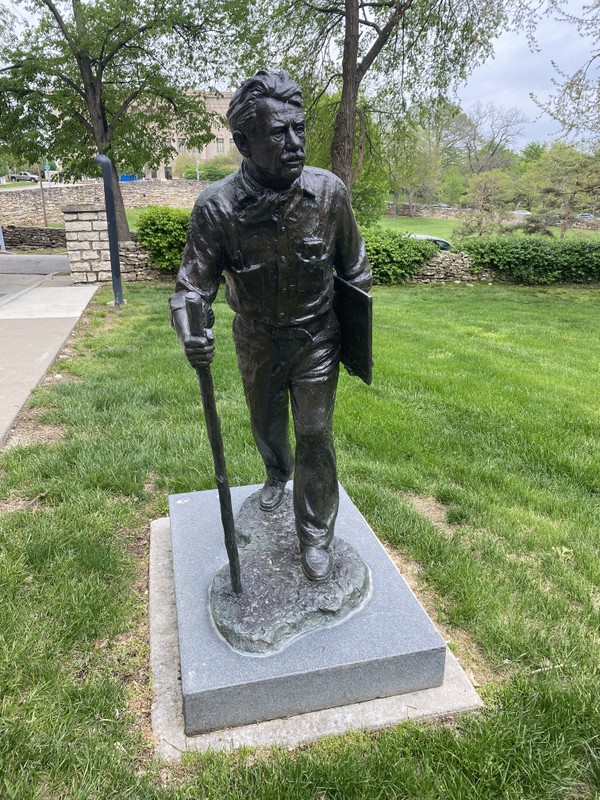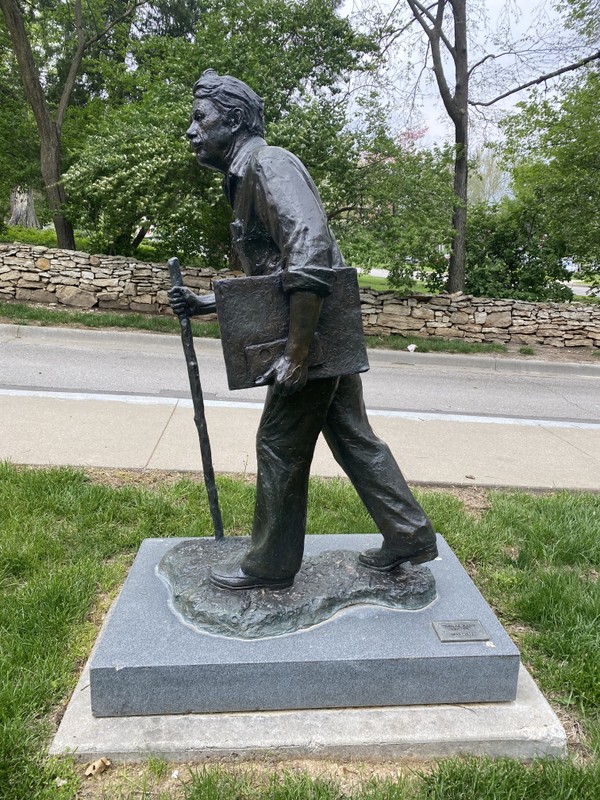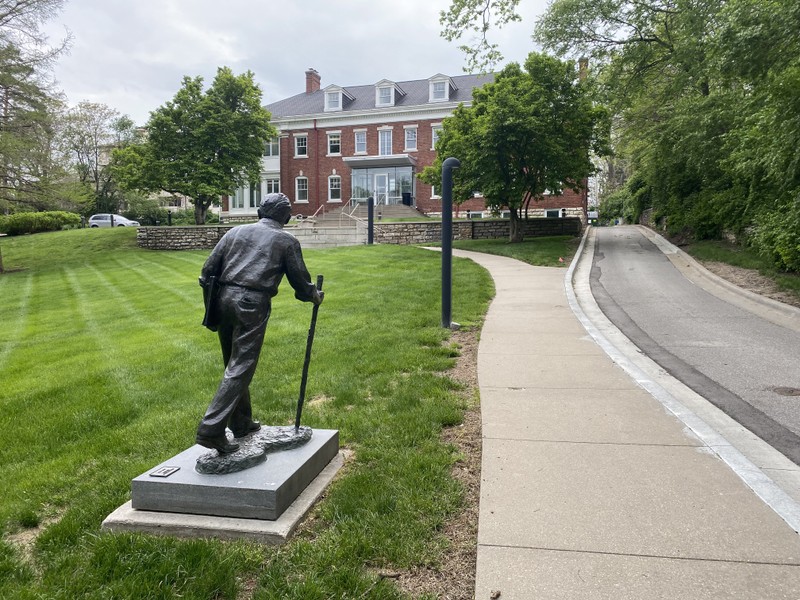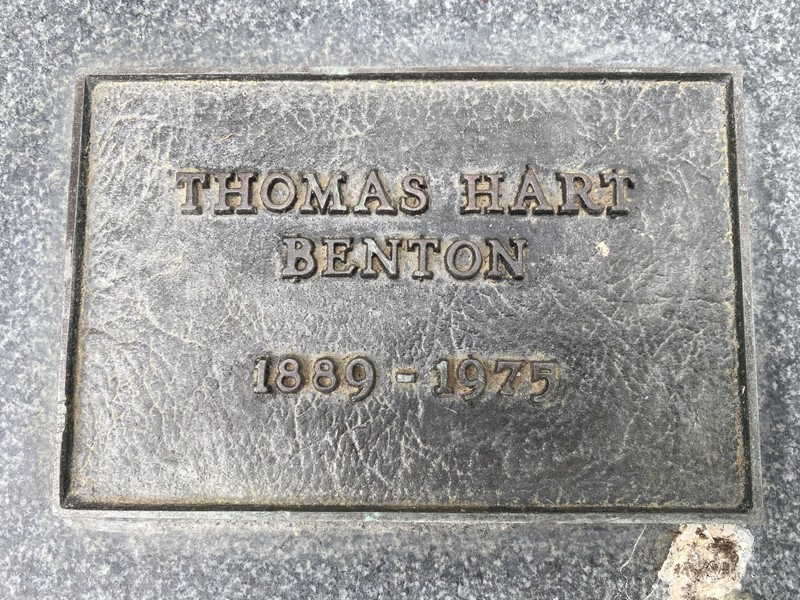Thomas Hart Benton Statue at the Kansas City Art Institute
Introduction
Text-to-speech Audio
In 1988, the Kansas City Art Institute dedicated this bronze statue of one of its former teachers, Thomas Hart Benton, along the sidewalk leading up to the Jannes Library. The building was once the Cunningham Estate, and Benton appears to be walking towards the historic building as he carries a sketchbook and other supplies and uses a walking stick to trek up the slight hill. The artist’s close friend Charles Banks Wilson crafted the life-size figure out of bronze. This statue permanently marks the relationship between the artist and the school.
Images
The piece is located along the drive leading to the Jannes Library and Learning Center.

Thomas Hart Benton (1988)

Thomas Hart Benton (1988)

Plaque on statue. Inscription reads: "Thomas Hart Benton. 1889-1975."

Backstory and Context
Text-to-speech Audio
After living in cities for decades, Thomas Hart Benton was tired of the intellectualism, wealth, elitism, and homosexuality those settings tended to maintain. The now-established artist started speaking out against the more radical creators surrounding him. Benton began a new chapter in his life by moving to Kansas City, Missouri. Based in the Midwest, he could fully embrace his Regionalist tendencies.
Benton finally became famous in the 1930s. At the same time, he alienated the New York and Paris establishments and insulted many famous artists of the time. He was especially hurtful to Alfred Stieglitz, a former mentor. Benton regarded modernism as unuseful for the average American. He claimed that abstract art could not represent the US because most people could not relate to it. Going against the rising current put Benton on many people’s bad sides. Benton inevitably lost this fight, given modernism’s influence during the 20th century.
Many critics also looked down on Benton’s style and subject matter. The bodies were awkward and twisted. The nostalgia for the folk past had nothing to do with the progress many desired in the modern age. Benton’s restraint and insistence on traditional life were regressive, not progressive, for these Marxists and other leftists. Benton also disliked the conservative academics who hated all experimentation. Returning to the Midwest would shield Benton somewhat from the criticism he faced. Escaping to a mid-size city would free the artist from the constraining forces he had grown to dislike.
However, Benton had an even bigger reason for leaving New York: homosexuals. According to Benton, gay men were “very important factors in the museums and galleries of the cities.”[1] These men and women were self-absorbed and forced everyone else to bend to their tastes. Nothing was wrong with being gay in private, and a few could set aside their inherent flaws. However, returning to the Midwest was the only way to escape the homosexual influence. Benton believed that only coastal cities allowed these people to be so open. Kansas City would be an escape from the horrors of excess and intellectualism.
The Kansas City Art Institute hired Benton in 1935 to chair its painting department. As he had in New York, he instructed students to create strong overall designs for their pieces. Despite a campaign to get Benton fired for his lack of shame around sex and nudity in 1938, his students and the school’s board considered him an excellent teacher. Thomas and Rita quickly entered the local social world. They hosted dinner parties and made many well-connected friends. Their daughter Jese was born in 1939. However, Benton’s teaching career came to an end in 1941. The Art Institute fired him after he told the press that homosexuals controlled all museums and that museums should not exist. Despite student and faculty support, Benton caused too much damage to his reputation for the school to retain him.
Nearly five decades after the Art Institute fired Benton, the school put a statue honoring him on its campus. This honor could be a way of apologizing to the artist, or it could show the school has forgotten about the past. The piece does not offer any information besides Benton’s name and lifespan. The slightly hidden location might point to some wish to hide the statue. Whatever the school intended, the existence of this figure should encourage viewers to think about who we honor and why.
Sources
- Benton, An Artist in America, 266.
Benton, Thomas Hart. An Artist in America. Edition 4. Columbia, MO. University of Missouri Press, 1983.
Doss, Erika. Benton, Pollock, and the Politics of Modernism: From Regionalism to Abstract Expressionism. Chicago. The University of Chicago Press, 1991.
Wolff, Justin. Thomas Hart Benton: A Life. New York. Farrar, Straus and Giroux, 2012.
Emily Van Cleave
Emily Van Cleave
Emily Van Cleave
Emily Van Cleave
